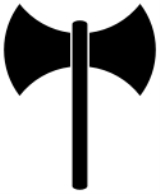
LGBT symbols
Encyclopedia
Lesbian
, Gay
, Bisexual, Transgender
, and Genderqueer
(LGBT
Q) communities have adopted certain symbol
s and symbolates for which they are identified and by which they demonstrate unity, pride
, shared values, and allegiance to one another. LGBTQ symbols also communicate ideas, concepts and identity both within their communities and to mainstream cultures. The two most-recognized international LGBTQ symbols are the pink triangle
and the pride flag
. The pink triangle, employed by the Nazis in World War II as a badge of shame was re-appropriated but retained some negative connotations. The Rainbow flag was envisioned and created to be a more organic and natural replacement without any negativity attached to it.
, which originated from the Nazi concentration camp badges
that homosexuals were required to wear on their clothing. Many of the estimated 5-15,000 gays and lesbians imprisoned in concentration camps perished alongside the 6,000,000 Jews whom the Nazis exterminated during World War II as part of The Holocaust
. For this reason, the Pink Triangle is used both as an identification symbol and as a memento to remind both its wearers and the general public of the atrocities that gays suffered under Nazi persecutors. AIDS Coalition to Unleash Power (ACT-UP) adopted the inverted pink triangle to symbolize the “active fight back” against HIV
/AIDS
“rather than a passive resignation to fate.”
While the pink triangle was used exclusively with male prisoners, lesbians were not included under Paragraph 175. However, women were arrested and imprisoned for "antisocial behavior," which include anything from feminism, lesbianism, and prostitution to any woman who didn't conform to the ideal Nazi image of a woman: cooking, cleaning, kitchen work, child raising, passive, etc. These women were labeled with a black triangle. Modern-day lesbians have reclaimed this symbol for themselves as gay men have reclaimed the pink triangle.
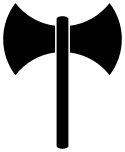 The labrys
The labrys
, or double-bladed battle axe, was a symbol used in the ancient civilization of Minoan Crete
(sometimes portrayed as having certain matriarchal tendencies). As a modern symbol, it is often used to represent lesbian and feminist strength and self-sufficiency. In use since the late 1970s.
 One symbol which continues to remain popular is the lower case Greek letter lambda
One symbol which continues to remain popular is the lower case Greek letter lambda
. The symbol was originally chosen by the Gay Activists Alliance of New York in 1970. The GAA was a group which broke away from the larger Gay Liberation Front at the end of 1969, only six months after its foundation in response to the Stonewall Riots. While the GLF wanted to work side by side with the black and women's liberation movements to gain unity and acceptance, the GAA wanted to focus their efforts more concisely on only Gay and Lesbian issues.
Because of its official adoption by the GAA, which sponsored public events for the gay community, the lambda soon became a quick way for the members of the gay community to identify each other. The reasoning was that the lambda would easily be mistaken for a college fraternity symbol and ignored by the majority of the population. Eventually, though, the GAA headquarters was torched by an arsonist, destroying not only the building but all of the organization's records, and the movement never recovered from the loss. The symbol, however, lived on.
What the symbol means, or meant when it was introduced, has been topic for speculation and a number of rumors. Some of the more popular speculations are:
Even though at one time it acquired a strictly male connotation, it is used by both gays and lesbians today. Back in December 1974, the lambda was officially declared the international symbol for gay and lesbian rights by the International Gay Rights Congress in Edinburgh, Scotland. Also, the lambda is said to signify unity under oppression. The gay rights organization Lambda Legal
and the American Lambda Literary Award
derive their names from this symbol.
 On Halloween
On Halloween
night (31 October), 1969, sixty members of the Gay Liberation Front
(GLF) and the Society for Individual Rights (SIR) staged a protest at San Francisco's Examiner in response to another in a series of news articles disparaging LGBT
people in San Francisco's gay bar
s and clubs. The peaceful protest against the "homophobic editorial policies" of the Examiner turned tumultuous and were later called "Friday of the Purple Hand" and "Bloody Friday of the Purple Hand". Examiner employees "dumped a bag of printers' ink from the third story window of the newspaper building onto the crowd". Some reports were that it was a barrel of ink poured from the roof of the building. The protestors "used the ink to scrawl "Gay Power" and other slogans on the building walls" and stamp purple hand prints "throughout downtown San Francisco" resulting in "one of the most visible demonstrations of gay power". According to Larry LittleJohn, then president of SIR, "At that point, the tactical squad arrived – not to get the employees who dumped the ink, but to arrest the demonstrators who were the victims. The police could have surrounded the Examiner building...but, no, they went after the gays...Somebody could have been hurt if that ink had gotten into their eyes, but the police came racing in with their clubs swinging, knocking people to the ground. It was unbelievable." The accounts of police brutality
include women being thrown to the ground and protesters' teeth being knocked out.
Inspired by "Black Hand" (La Mano Nera in Italian
) extortion
methods of Camorra
gangster
s and the Mafia
, some activists attempted to institute "purple hand" as a gay and lesbian symbol as a warning to stop anti-gay attacks, with little success. In Turkey, the LGBT rights organization MorEl Eskişehir LGBTT Oluşumu (Purple Hand Eskişehir LGBT Formation), also bears the name of this symbol.

Version with hot pink removed due to fabric unavailability. (1978–1979)
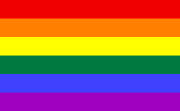
Six-color version popular since 1979. Number of stripes reduced to an even number to prevent middle color from being hidden when hung vertically on lampposts, indigo changed to royal blue
Lesbian
Lesbian is a term most widely used in the English language to describe sexual and romantic desire between females. The word may be used as a noun, to refer to women who identify themselves or who are characterized by others as having the primary attribute of female homosexuality, or as an...
, Gay
Gay
Gay is a word that refers to a homosexual person, especially a homosexual male. For homosexual women the specific term is "lesbian"....
, Bisexual, Transgender
Transgender
Transgender is a general term applied to a variety of individuals, behaviors, and groups involving tendencies to vary from culturally conventional gender roles....
, and Genderqueer
Genderqueer
Genderqueer is a catch-all term for gender identities other than man and woman, thus outside of the gender binary and heteronormativity...
(LGBT
LGBT
LGBT is an initialism that collectively refers to "lesbian, gay, bisexual, and transgender" people. In use since the 1990s, the term "LGBT" is an adaptation of the initialism "LGB", which itself started replacing the phrase "gay community" beginning in the mid-to-late 1980s, which many within the...
Q) communities have adopted certain symbol
Symbol
A symbol is something which represents an idea, a physical entity or a process but is distinct from it. The purpose of a symbol is to communicate meaning. For example, a red octagon may be a symbol for "STOP". On a map, a picture of a tent might represent a campsite. Numerals are symbols for...
s and symbolates for which they are identified and by which they demonstrate unity, pride
Gay pride
LGBT pride or gay pride is the concept that lesbian, gay, bisexual, and transgender people should be proud of their sexual orientation and gender identity...
, shared values, and allegiance to one another. LGBTQ symbols also communicate ideas, concepts and identity both within their communities and to mainstream cultures. The two most-recognized international LGBTQ symbols are the pink triangle
Pink triangle
The pink triangle was one of the Nazi concentration camp badges, used to identify male prisoners who were sent there because of their homosexuality. Every prisoner had to wear a downward-pointing triangle on his or her jacket, the colour of which was to categorise him or her by "kind"...
and the pride flag
Rainbow flag (LGBT movement)
The rainbow flag, sometimes pride flag, LGBT pride flag or gay pride flag, is a symbol of lesbian, gay, bisexual, and transgender pride and LGBT social movements in use since the 1970s. The colours reflect the diversity of the LGBT community, and the flag is often used as a symbol of gay pride in...
. The pink triangle, employed by the Nazis in World War II as a badge of shame was re-appropriated but retained some negative connotations. The Rainbow flag was envisioned and created to be a more organic and natural replacement without any negativity attached to it.
Triangles during World War II
One of the oldest of these symbols is the pink trianglePink triangle
The pink triangle was one of the Nazi concentration camp badges, used to identify male prisoners who were sent there because of their homosexuality. Every prisoner had to wear a downward-pointing triangle on his or her jacket, the colour of which was to categorise him or her by "kind"...
, which originated from the Nazi concentration camp badges
Nazi concentration camp badges
Nazi concentration camp badges, primarily triangles, were part of the system of identification in Nazi camps. They were used in the concentration camps in the Nazi-occupied countries to identify the reason the prisoners had been placed there. The triangles were made of fabric and were sewn on...
that homosexuals were required to wear on their clothing. Many of the estimated 5-15,000 gays and lesbians imprisoned in concentration camps perished alongside the 6,000,000 Jews whom the Nazis exterminated during World War II as part of The Holocaust
The Holocaust
The Holocaust , also known as the Shoah , was the genocide of approximately six million European Jews and millions of others during World War II, a programme of systematic state-sponsored murder by Nazi...
. For this reason, the Pink Triangle is used both as an identification symbol and as a memento to remind both its wearers and the general public of the atrocities that gays suffered under Nazi persecutors. AIDS Coalition to Unleash Power (ACT-UP) adopted the inverted pink triangle to symbolize the “active fight back” against HIV
HIV
Human immunodeficiency virus is a lentivirus that causes acquired immunodeficiency syndrome , a condition in humans in which progressive failure of the immune system allows life-threatening opportunistic infections and cancers to thrive...
/AIDS
AIDS
Acquired immune deficiency syndrome or acquired immunodeficiency syndrome is a disease of the human immune system caused by the human immunodeficiency virus...
“rather than a passive resignation to fate.”
While the pink triangle was used exclusively with male prisoners, lesbians were not included under Paragraph 175. However, women were arrested and imprisoned for "antisocial behavior," which include anything from feminism, lesbianism, and prostitution to any woman who didn't conform to the ideal Nazi image of a woman: cooking, cleaning, kitchen work, child raising, passive, etc. These women were labeled with a black triangle. Modern-day lesbians have reclaimed this symbol for themselves as gay men have reclaimed the pink triangle.
| Pink Triangle | Black Triangle | Pink & Yellow Triangles | Nazi Chart |
|---|---|---|---|
 |
 |
 |
 |
The pink triangle Pink triangle The pink triangle was one of the Nazi concentration camp badges, used to identify male prisoners who were sent there because of their homosexuality. Every prisoner had to wear a downward-pointing triangle on his or her jacket, the colour of which was to categorise him or her by "kind"... was originally used to denote homosexual men as a Nazi concentration camp badge Nazi concentration camp badges Nazi concentration camp badges, primarily triangles, were part of the system of identification in Nazi camps. They were used in the concentration camps in the Nazi-occupied countries to identify the reason the prisoners had been placed there. The triangles were made of fabric and were sewn on... . |
The black triangle was used to mark "asocial" and "workshy" individuals, including prostitutes Prostitution Prostitution is the act or practice of providing sexual services to another person in return for payment. The person who receives payment for sexual services is called a prostitute and the person who receives such services is known by a multitude of terms, including a "john". Prostitution is one of... , Roma and others in the camps. It has been adapted as a lesbian symbol. |
The pink triangle overlapping a yellow triangle was used to tag Jewish homosexuals in Nazi concentration camps. |
A chart, circa 1938–1942, of prisoner markings used in German concentration camps. The 5th column from the left was for homosexual men. |
Labrys

Labrys
Labrys is the term for a symmetrical doubleheaded axe originally from Crete in Greece, one of the oldest symbols of Greek civilization; to the Romans, it was known as a bipennis....
, or double-bladed battle axe, was a symbol used in the ancient civilization of Minoan Crete
Minoan civilization
The Minoan civilization was a Bronze Age civilization that arose on the island of Crete and flourished from approximately the 27th century BC to the 15th century BC. It was rediscovered at the beginning of the 20th century through the work of the British archaeologist Arthur Evans...
(sometimes portrayed as having certain matriarchal tendencies). As a modern symbol, it is often used to represent lesbian and feminist strength and self-sufficiency. In use since the late 1970s.
Lambda

Lambda
Lambda is the 11th letter of the Greek alphabet. In the system of Greek numerals lambda has a value of 30. Lambda is related to the Phoenician letter Lamed . Letters in other alphabets that stemmed from lambda include the Roman L and the Cyrillic letter El...
. The symbol was originally chosen by the Gay Activists Alliance of New York in 1970. The GAA was a group which broke away from the larger Gay Liberation Front at the end of 1969, only six months after its foundation in response to the Stonewall Riots. While the GLF wanted to work side by side with the black and women's liberation movements to gain unity and acceptance, the GAA wanted to focus their efforts more concisely on only Gay and Lesbian issues.
Because of its official adoption by the GAA, which sponsored public events for the gay community, the lambda soon became a quick way for the members of the gay community to identify each other. The reasoning was that the lambda would easily be mistaken for a college fraternity symbol and ignored by the majority of the population. Eventually, though, the GAA headquarters was torched by an arsonist, destroying not only the building but all of the organization's records, and the movement never recovered from the loss. The symbol, however, lived on.
What the symbol means, or meant when it was introduced, has been topic for speculation and a number of rumors. Some of the more popular speculations are:
- Simply, the Greek letter "L" stands for "liberation."
- The Greek Spartans believed that the lambda represented unity.
- The Romans took it as meaning "the light of knowledge shining into the darkness of ignorance."
- The charged energy of the gay movement. This stems from the lambda's use in chemistry and physics to denote wavelength in equations, related to energy according to wave-particle duality
- The synergy which results when gays and lesbians work together towards a common goal (a gestalt theory which also stems from the physics-energy theory)
- The notion that straights and gays, or gays and lesbians, or any pairing of these three, are on different wavelengths when it comes to sex, sexuality, or even brain patterns. This again comes from the lambda's presence in chemistry and physics, where it is sometimes used to represent the wavelength of certain types of energy.
- An iconic rendering of the scales of justice and the constant force that keeps opposing sides from overcoming each other. The hook at the bottom of the right leg would then signify the action and initiative needed to reach and maintain balance.
- The lambda is also thought by some to have appeared on the shields of warriors from Sparta (the lambda specifically resulting from the name LaconiaLaconiaLaconia , also known as Lacedaemonia, is one of the regional units of Greece. It is part of the region of Peloponnese. It is situated in the southeastern part of the Peloponnese peninsula. Its administrative capital is Sparti...
.) The lambda was associated with the Spartans because they were also known as the Lacedaemonians.
Even though at one time it acquired a strictly male connotation, it is used by both gays and lesbians today. Back in December 1974, the lambda was officially declared the international symbol for gay and lesbian rights by the International Gay Rights Congress in Edinburgh, Scotland. Also, the lambda is said to signify unity under oppression. The gay rights organization Lambda Legal
Lambda Legal
Lambda Legal is an American civil rights organization that focuses on lesbian, gay, bisexual, transgender communities as well as people living with HIV/AIDS through impact litigation, education, and public policy work.Lambda's founder William J. Thom, Esq...
and the American Lambda Literary Award
Lambda Literary Award
Lambda Literary Awards are awarded yearly by the US-based Lambda Literary Foundation to published works which celebrate or explore LGBT themes. Categories include Humor, Romance and Biography. To qualify, a book must have been published in the United States in the year current to the award...
derive their names from this symbol.
Purple hand

Halloween
Hallowe'en , also known as Halloween or All Hallows' Eve, is a yearly holiday observed around the world on October 31, the night before All Saints' Day...
night (31 October), 1969, sixty members of the Gay Liberation Front
Gay Liberation Front
Gay Liberation Front was the name of a number of Gay Liberation groups, the first of which was formed in New York City in 1969, immediately after the Stonewall riots, in which police clashed with gay demonstrators.-The Gay Liberation Front:...
(GLF) and the Society for Individual Rights (SIR) staged a protest at San Francisco's Examiner in response to another in a series of news articles disparaging LGBT
LGBT
LGBT is an initialism that collectively refers to "lesbian, gay, bisexual, and transgender" people. In use since the 1990s, the term "LGBT" is an adaptation of the initialism "LGB", which itself started replacing the phrase "gay community" beginning in the mid-to-late 1980s, which many within the...
people in San Francisco's gay bar
Gay bar
A gay bar is a drinking establishment that caters to an exclusively or predominantly gay, lesbian, bisexual, and transgender clientele; the term gay is used as a broadly inclusive concept for LGBT and queer communities...
s and clubs. The peaceful protest against the "homophobic editorial policies" of the Examiner turned tumultuous and were later called "Friday of the Purple Hand" and "Bloody Friday of the Purple Hand". Examiner employees "dumped a bag of printers' ink from the third story window of the newspaper building onto the crowd". Some reports were that it was a barrel of ink poured from the roof of the building. The protestors "used the ink to scrawl "Gay Power" and other slogans on the building walls" and stamp purple hand prints "throughout downtown San Francisco" resulting in "one of the most visible demonstrations of gay power". According to Larry LittleJohn, then president of SIR, "At that point, the tactical squad arrived – not to get the employees who dumped the ink, but to arrest the demonstrators who were the victims. The police could have surrounded the Examiner building...but, no, they went after the gays...Somebody could have been hurt if that ink had gotten into their eyes, but the police came racing in with their clubs swinging, knocking people to the ground. It was unbelievable." The accounts of police brutality
Police brutality
Police brutality is the intentional use of excessive force, usually physical, but potentially also in the form of verbal attacks and psychological intimidation, by a police officer....
include women being thrown to the ground and protesters' teeth being knocked out.
Inspired by "Black Hand" (La Mano Nera in Italian
Italian language
Italian is a Romance language spoken mainly in Europe: Italy, Switzerland, San Marino, Vatican City, by minorities in Malta, Monaco, Croatia, Slovenia, France, Libya, Eritrea, and Somalia, and by immigrant communities in the Americas and Australia...
) extortion
Extortion
Extortion is a criminal offence which occurs when a person unlawfully obtains either money, property or services from a person, entity, or institution, through coercion. Refraining from doing harm is sometimes euphemistically called protection. Extortion is commonly practiced by organized crime...
methods of Camorra
Camorra
The Camorra is a Mafia-type criminal organization, or secret society, originating in the region of Campania and its capital Naples in Italy. It is one of the oldest and largest criminal organizations in Italy, dating to the 18th century.-Background:...
gangster
Gangster
A gangster is a criminal who is a member of a gang. Some gangs are considered to be part of organized crime. Gangsters are also called mobsters, a term derived from mob and the suffix -ster....
s and the Mafia
Mafia
The Mafia is a criminal syndicate that emerged in the mid-nineteenth century in Sicily, Italy. It is a loose association of criminal groups that share a common organizational structure and code of conduct, and whose common enterprise is protection racketeering...
, some activists attempted to institute "purple hand" as a gay and lesbian symbol as a warning to stop anti-gay attacks, with little success. In Turkey, the LGBT rights organization MorEl Eskişehir LGBTT Oluşumu (Purple Hand Eskişehir LGBT Formation), also bears the name of this symbol.
Pride flag and colors
Original eight-stripe version designed by Gilbert Baker in 1978
Version with hot pink removed due to fabric unavailability. (1978–1979)

Six-color version popular since 1979. Number of stripes reduced to an even number to prevent middle color from being hidden when hung vertically on lampposts, indigo changed to royal blue
Rainbow flag
Gilbert BakerGilbert Baker (artist)
Gilbert Baker is an artist and civil rights activist who in 1978 designed the Rainbow Flag, sometimes called the Pride Flag, Gay Pride Flag, or, since the early 1990s, Queer Flag, that is often used as a symbol of gay pride in LGBT rights marches.-Biography:Baker served in the U.S. Army from 1970...
designed the rainbow flag for the 1978 San Francisco's Gay Freedom Celebration. The flag does not depict or show an actual rainbow. Rather, the colors of the rainbow are displayed as horizontal stripes, with red at the top and purple at the bottom. It represents the diversity of gays and lesbians around the world. The purple stripe is sometimes replaced with a black stripe to show masculinity or leather pride. In the original eight-strip version, pink stood for sexuality, red for life, orange for healing, yellow for the sun, green for nature, turquoise for art, indigo for harmony and violet for the soul. The original eight color rainbow flag flies over the Castro in San Francisco and from the Lesbian, Gay, Bisexual, and Transgender Community Center in New York City.
Pride colors

Freedom rings
Freedom rings, designed by David Spada, are six aluminum rings, each in one of the colors of the rainbow flag. They were originally released in 1991.Symbolizing happiness and diversity, these rings are worn as themselves or as part of necklaces, bracelets, and key chains.
They are sometimes referred to as "Fruit Loops". For National Coming Out Day
National Coming Out Day
National Coming Out Day is an internationally observed civil awareness day celebrating individuals who publicly identify as bisexual, gay, lesbian, transgender—coming out regarding one's sexual orientation and/or gender identity being akin to a cultural rite of passage for LGBT people...
(held in the United States on 11 October) students have made home-made versions of the "freedom rings" with actual Froot Loops
Froot Loops
Froot Loops is a brand of breakfast cereal produced by Kellogg's and sold in Hungary, Mexico, Canada, New Zealand, Australia, the United States, South Korea, Philippines, Thailand, Germany, The Middle East, The Caribbean, South Africa, Latin America, Sweden and Finland...
cereal.
Bisexuality symbols – flag, triangles, and moons
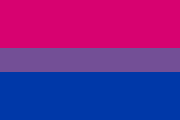


First unveiled on 5 December 1998, the bisexual pride flag
Bisexual pride flag
The bisexual pride flag was designed by Michael Page in 1998 in order to give the bisexual community its own symbol comparable to the Gay pride flag of the larger LGBT community...
was designed by Michael Page to represent the Bisexual community
Bisexual community
Bisexual community is a term used to describe members of the LGBT community who identify as bisexual, pansexual, "fluid", and queer-identified, as well as their allies...
. This rectangular flag consists of a broad magenta stripe at the top, representing same-gender attraction; a broad stripe in blue at the bottom, representing opposite-gender attraction; and a narrower deep lavender band occupying the central fifth, which represents attraction towards both genders.
The blue and pink overlapping triangle symbol represents bisexuality
Bisexuality
Bisexuality is sexual behavior or an orientation involving physical or romantic attraction to both males and females, especially with regard to men and women. It is one of the three main classifications of sexual orientation, along with a heterosexual and a homosexual orientation, all a part of the...
and bi pride. The exact origin of this symbol, sometimes facetiously referred to as the "biangles", remains ambiguous. It is popularly thought that the pink triangle may represent homosexuality, as it does when it stands alone, while the blue stands for heterosexuality. The two together form the color lavender, a blend of both sexual orientations and a color that has been associated with homosexuality for almost a century. It's also possible that the pink may represent attraction to females, the blue attraction to males and lavender attraction to both. The bisexual moon symbol was created to avoid the use of the Nazi-originated pink triangle.
Gender symbols

Gender symbol
A gender symbol is a symbol used to denote the sex of a life form or to characterize an agent by gender.The two standard gender symbols denoting male ♂ and female ♀ are derived from astrological symbols, denoting the classical planets Mars and Venus, respectively.These symbols have been in use...
(based on astrological symbols
Astrological symbols
Astrological symbols are images used in various astrological systems to denote relevant objects. A number of such images are shown below.-History and origin:...
, Mars for male and Venus for female) have appeared to express various LBGT "gender identities" since the 1990s.
Pairs of male and female gender symbols are used to form symbols for gay and lesbian. Two interlocking male symbols form a gay male symbol. Two interlocking female symbols form a lesbian symbol. Variations on this theme can be used to represent bisexuals, transgender persons, as well as heterosexuals.
Transgender symbols
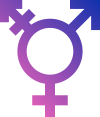

Strikethrough
Strikethrough is a typographical presentation of words with a horizontal line through their center. This is an example....
arrow (combining the female cross and male arrow) projecting from the top-left.
Another transgender symbol is the Transgender Pride flag
Transgender Pride flag
Transgender flags the Transgender Pride flag is a symbol of transgender pride and diversity, and transgender rights.The Transgender Pride flag was created by Monica Helms in 1999, and was first shown at a pride parade in Phoenix, Arizona, United States in 2000.The flag represents the transgender...
designed by Monica Helms, and first shown at a pride parade in Phoenix, Arizona, USA in 2000. The flag represents the transgender community and consists of five horizontal stripes, two light blue, two pink, with a white stripe in the center. Helms described the meaning of the flag as follows:
Other transgender symbols include the butterfly
Butterfly
A butterfly is a mainly day-flying insect of the order Lepidoptera, which includes the butterflies and moths. Like other holometabolous insects, the butterfly's life cycle consists of four parts: egg, larva, pupa and adult. Most species are diurnal. Butterflies have large, often brightly coloured...
(symbolizing transformation or metamorphosis), and a pink/light blue yin and yang
Yin and yang
In Asian philosophy, the concept of yin yang , which is often referred to in the West as "yin and yang", is used to describe how polar opposites or seemingly contrary forces are interconnected and interdependent in the natural world, and how they give rise to each other in turn. Opposites thus only...
symbol.
Bear culture

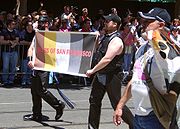
Bear is an affectionate gay slang
Gay slang
LGBT slang, LGBT speak or gay slang is a set of slang used predominantly among lesbian, gay, bisexual and transgender people. It has been used in various languages, including English and Japanese since the early 1900s as a means by members of the LGBT community as a group to self-advertise as a...
term for those in the bear communities, a subculture in the gay community
Gay community
The gay community, or LGBT community, is a loosely defined grouping of LGBT and LGBT-supportive people, organizations and subcultures, united by a common culture and civil rights movements. These communities generally celebrate pride, diversity, individuality, and sexuality...
and an emerging subset of LGBT communities with events, codes and culture specific identity. Bears tend to have hairy bodies and facial hair
Facial hair
Facial hair is a secondary sex characteristic of human males. Men often start developing facial hair in the later years of puberty or adolescence, approximately between 17–20 years of age, and most do not finish developing a fully adult beard until their early 20s or even later...
; some are heavy-set
Overweight
Overweight is generally defined as having more body fat than is optimally healthy. Being overweight is a common condition, especially where food supplies are plentiful and lifestyles are sedentary...
; some project an image of working-class masculinity
Masculinity
Masculinity is possessing qualities or characteristics considered typical of or appropriate to a man. The term can be used to describe any human, animal or object that has the quality of being masculine...
in their grooming
Personal grooming
Personal grooming is the art of cleaning, grooming, and maintaining parts of the body. It is a species-typical behavior that is controlled by neural circuits in the brain.- In humans :...
and appearance, though none of these are requirements or unique indicators. The bear concept can function as an identity, an affiliation, and an ideal to live up to, and there is ongoing debate in bear communities about what constitutes a bear. Some state that self-identifying as a bear is the only requirement, while others argue that bears must have certain physical characteristics—such as a hairy chest and face or having a large body—and a certain mode of dress and behavior.
"Bears" are almost always gay
Gay
Gay is a word that refers to a homosexual person, especially a homosexual male. For homosexual women the specific term is "lesbian"....
or bisexual
Bisexuality
Bisexuality is sexual behavior or an orientation involving physical or romantic attraction to both males and females, especially with regard to men and women. It is one of the three main classifications of sexual orientation, along with a heterosexual and a homosexual orientation, all a part of the...
men although increasingly transgender
Transgender
Transgender is a general term applied to a variety of individuals, behaviors, and groups involving tendencies to vary from culturally conventional gender roles....
men (regardless of their sexuality) and those who shun labels for gender
Gender
Gender is a range of characteristics used to distinguish between males and females, particularly in the cases of men and women and the masculine and feminine attributes assigned to them. Depending on the context, the discriminating characteristics vary from sex to social role to gender identity...
and sexuality
Sexual identity
Sexual identity is a term that, like sex, has two distinctively different meanings. One describes an identity roughly based on sexual orientation, the other an identity based on sexual characteristics, which is not socially based but based on biology, a concept related to, but different from,...
are also included within bear communities. The Bear community has spread all over the world, with Bear clubs in many countries. Bear clubs often serve as social and sexual networks for older, hairier, sometimes heavier gay and bisexual men, and members often contribute to their local gay communities through fundraising and other functions. Bear events are common in heavily-gay communities.
The International Bear Brotherhood Flag was designed in 1995 by Craig Byrnes(VA Copyright 760–763 digital graphic by Paul Witzkoske for Bear Manufacturing).
Leather sub-culture
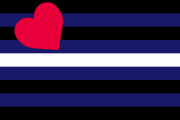
Eroticism
Eroticism is generally understood to refer to a state of sexual arousal or anticipation of such – an insistent sexual impulse, desire, or pattern of thoughts, as well as a philosophical contemplation concerning the aesthetics of sexual desire, sensuality and romantic love...
("kink
Kink (sexual)
In human sexuality, kinkiness and kinky are terms used to refer to a playful usage of sexual concepts in an accentuated, and unambiguously expressive form....
"). Wearing leather garments is one way that participants in this culture self-consciously distinguish themselves from mainstream sexual cultures. Leather culture is most visible in gay communities
Gay community
The gay community, or LGBT community, is a loosely defined grouping of LGBT and LGBT-supportive people, organizations and subcultures, united by a common culture and civil rights movements. These communities generally celebrate pride, diversity, individuality, and sexuality...
and most often associated with gay men ("leathermen"), but it is also reflected in various ways in the gay
Gay
Gay is a word that refers to a homosexual person, especially a homosexual male. For homosexual women the specific term is "lesbian"....
, lesbian
Lesbian
Lesbian is a term most widely used in the English language to describe sexual and romantic desire between females. The word may be used as a noun, to refer to women who identify themselves or who are characterized by others as having the primary attribute of female homosexuality, or as an...
, bisexual, and straight worlds. Many people associate leather culture with BDSM
BDSM
BDSM is an erotic preference and a form of sexual expression involving the consensual use of restraint, intense sensory stimulation, and fantasy power role-play. The compound acronym BDSM is derived from the terms bondage and discipline , dominance and submission , and sadism and masochism...
(Bondage/Discipline, Dominance/Submission, Sado/Masochism, also called "S & M") practice. But for others, wearing black leather
Leather
Leather is a durable and flexible material created via the tanning of putrescible animal rawhide and skin, primarily cattlehide. It can be produced through different manufacturing processes, ranging from cottage industry to heavy industry.-Forms:...
clothing is an erotic
Eroticism
Eroticism is generally understood to refer to a state of sexual arousal or anticipation of such – an insistent sexual impulse, desire, or pattern of thoughts, as well as a philosophical contemplation concerning the aesthetics of sexual desire, sensuality and romantic love...
fashion
Fashion
Fashion, a general term for a currently popular style or practice, especially in clothing, foot wear, or accessories. Fashion references to anything that is the current trend in look and dress up of a person...
that expresses heightened masculinity
Masculinity
Masculinity is possessing qualities or characteristics considered typical of or appropriate to a man. The term can be used to describe any human, animal or object that has the quality of being masculine...
or the appropriation of sexual power; love of motorcycle
Motorcycle
A motorcycle is a single-track, two-wheeled motor vehicle. Motorcycles vary considerably depending on the task for which they are designed, such as long distance travel, navigating congested urban traffic, cruising, sport and racing, or off-road conditions.Motorcycles are one of the most...
s and independence; and engagement in sexual kink
Kink (sexual)
In human sexuality, kinkiness and kinky are terms used to refer to a playful usage of sexual concepts in an accentuated, and unambiguously expressive form....
or leather fetishism.
The Leather Pride Flag
Leather Pride flag
The Leather Pride Flag is a symbol used by the leather subculture since the 1990s. It was designed by Tony DeBlase in 1989, and was quickly embraced by the gay Leather community. It has since become associated with Leather in general and also with related groups.-History:The flag was designed by...
was designed by Tony DeBlase, and he first presented the design at the International Mr. Leather event in Chicago, Illinois, USA on 28 May 1989.
Another name that is used to describe the leather flag is "Black and Blue with Love".
Butch and femme symbols
Historically, a blue star has been used as a symbol of butchness. The site Butch-Femme.com uses a black triangle in a red circle to represent butch/femme sexuality.Asexual
In August 2010, after a process of trying to get the word out, even outside AVEN and non-English speaking areas a flag was eventually voted on in a non-AVEN site and then elected. It has since been seen used on tumblrTumblr
Tumblr is a website and microblogging platform that allows users to post text, images, videos, links, quotes and audio to their tumblelog, a short-form blog. Users can follow other users, or choose to make their tumblelog private. The service emphasizes ease of use. The site ranks as the 10th...
in various LGBTQ etc. areas, and had in fact been seen alongside other Sexual Orientations flags previous to formal election. The black stripe represents asexuality, the grey stripe grey-asexuality and the demisexuals
Demisexuality
Demisexuality is the lack of sexual attraction outside of strong emotional connection. It is distinct from, but related to, asexuality, the complete lack of sexual attraction. The term comes from the orientation being "halfway between" sexual and asexual...
, the white stripe sexuality and the purple stripe community.
Other symbols
In addition to these major symbols of the LGBT community, other lesser symbols have been used to represent members’ unity, pride, shared values, and allegiance to one another.
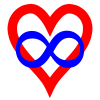

Polyamory
Polyamory is the practice, desire, or acceptance of having more than one intimate relationship at a time with the knowledge and consent of everyone involved....
movement has introduced the "love outside the box" symbol for use by polyamorous and non-monogamous people and LGBT
LGBT
LGBT is an initialism that collectively refers to "lesbian, gay, bisexual, and transgender" people. In use since the 1990s, the term "LGBT" is an adaptation of the initialism "LGB", which itself started replacing the phrase "gay community" beginning in the mid-to-late 1980s, which many within the...
Q individuals.
The symbol for Relationship anarchy (RA; sometimes known as "Radical Relations") was created by the Swedish radical art collective "Interacting arts" in 2006, as a symbol for those who reject all normative ideas of how relationships "should" be organised.
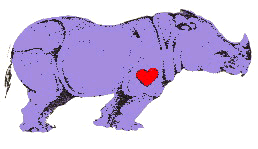
Boston
Boston is the capital of and largest city in Massachusetts, and is one of the oldest cities in the United States. The largest city in New England, Boston is regarded as the unofficial "Capital of New England" for its economic and cultural impact on the entire New England region. The city proper had...
chose the purple rhinoceros
Rhinoceros
Rhinoceros , also known as rhino, is a group of five extant species of odd-toed ungulates in the family Rhinocerotidae. Two of these species are native to Africa and three to southern Asia....
as a symbol of the gay movement after conducting a media campaign for this purpose (1974), selecting this animal because, although it is sometimes misunderstood, it is really both docile and intelligent – but when a rhinoceros is angered, it fights ferociously. Lavender was used because it was a widely recognized gay pride color and the heart was added to represent love and the "common humanity of all people."

Ancient Rome
Ancient Rome was a thriving civilization that grew on the Italian Peninsula as early as the 8th century BC. Located along the Mediterranean Sea and centered on the city of Rome, it expanded to one of the largest empires in the ancient world....
, as in 19th-century England, green
Green
Green is a color, the perception of which is evoked by light having a spectrum dominated by energy with a wavelength of roughly 520–570 nanometres. In the subtractive color system, it is not a primary color, but is created out of a mixture of yellow and blue, or yellow and cyan; it is considered...
indicated homosexual affiliations. Victorian
Victorian era
The Victorian era of British history was the period of Queen Victoria's reign from 20 June 1837 until her death on 22 January 1901. It was a long period of peace, prosperity, refined sensibilities and national self-confidence...
men would often pin a green carnation on their lapel as popularized by author Oscar Wilde
Oscar Wilde
Oscar Fingal O'Flahertie Wills Wilde was an Irish writer and poet. After writing in different forms throughout the 1880s, he became one of London's most popular playwrights in the early 1890s...
, who often sported one on his lapel.

Walt Whitman
Walter "Walt" Whitman was an American poet, essayist and journalist. A humanist, he was a part of the transition between transcendentalism and realism, incorporating both views in his works. Whitman is among the most influential poets in the American canon, often called the father of free verse...
used the calamus
Sweet Flag
Acorus calamus, commonly known as Sweet Flag or Calamus and erroneously as "rush" or "sedges", is a plant from the Acoraceae family, in the genus Acorus. It is a tall perennial wetland monocot with scented leaves and more strongly scented rhizomes...
plant to represent homoerotic love.

Sappho
Sappho was an Ancient Greek poet, born on the island of Lesbos. Later Greeks included her in the list of nine lyric poets. Her birth was sometime between 630 and 612 BC, and it is said that she died around 570 BC, but little is known for certain about her life...
described, in a poem, herself and a lover wearing garlands of violets. The giving of violets was popular from the 1910s to the 50s.
In the Society for Creative Anachronism
Society for Creative Anachronism
The Society for Creative Anachronism is an international living history group with the aim of studying and recreating mainly Medieval European cultures and their histories before the 17th century...
, LGBT members often wear a blue feather to indicate membership in or an affinity for Clan Blue Feather, a group of SCA members promoting the study of homosexuality in the Middle Ages.
- In the United Kingdom, the Pink Jack has been widely used in recent years to demonstrate a unique British Gay and Lesbian identity.
See also
- EmblemEmblemAn emblem is a pictorial image, abstract or representational, that epitomizes a concept — e.g., a moral truth, or an allegory — or that represents a person, such as a king or saint.-Distinction: emblem and symbol:...
- GlyphGlyphA glyph is an element of writing: an individual mark on a written medium that contributes to the meaning of what is written. A glyph is made up of one or more graphemes....
- Grapheme
- Hanky code
- IconIconAn icon is a religious work of art, most commonly a painting, from Eastern Christianity and in certain Eastern Catholic churches...
(religious) and secular iconSecular iconA secular icon is an image or pictograph of a person or thing used for other than religious purpose. -Icons versus symbols:...
- LGBT slogans
- List of symbols
- LogoLogoA logo is a graphic mark or emblem commonly used by commercial enterprises, organizations and even individuals to aid and promote instant public recognition...
- National symbol
- Religious symbolismReligious symbolismReligious symbolism is the use of symbols, including archetypes, acts, artwork, events, or natural phenomena, by a religion. Religions view religious texts, rituals, and works of art as symbols of compelling ideas or ideals...
- White knotWhite knotThe White Knot is a symbol of support for Same-sex marriage in the United States.The White Knot combines two symbols of marriage, the color white and "tying the knot" to represent support for same-sex marriage...
|}
External links
- http://www.swade.net/gallery/symbols.html shows images of some of these symbols and offers a brief historical account of each of them.

